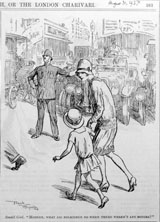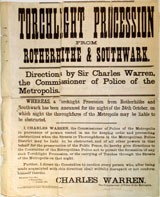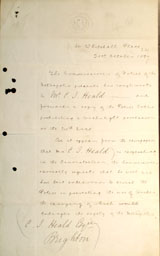Worksheet
Read the two documents relating to the torchlight procession advertised for 24 October 1887.
A transcript of the letter is available. |
||
Click on any image for a larger view.
Specimen answers/discussion
- The Commissioner's order and letter prohibit the procession. He explains in the letter to Mr Heald that his instruction is because the carrying of torches could endanger the metropolis – remember that, in that late 1880s, these would have been flaming torches, not electric ones. There was, therefore, the potential for people in the crush of a procession being burned, or dropping a torch and causing a fire. In more general terms, a procession through the streets can obstruct those streets to both pedestrians and the normal traffic. The poster notes the Commissioner's authority for keeping order and preventing obstructions.
- Your answer here will be a matter of opinion – as was the Commissioner's directive. From the limited evidence provided here, he was concerned that the procession might endanger the metropolis. Very probably the organisers of the procession, and no doubt a large number of those preparing to participate, did not consider that they would be a danger. This brings us to the heart of much public order policing. A judgement has to be made about what is, and what is not, a threat to public order. Moreover the eventual decision that an officer (whether as in this case the Commissioner, or in the case of a commotion involving a few people) has to make, will prompt a reaction – sometimes favourable, sometimes not – from those members of the public involved.
 "Mother, what did policemen do when there weren't any motors?"
"Mother, what did policemen do when there weren't any motors?"

